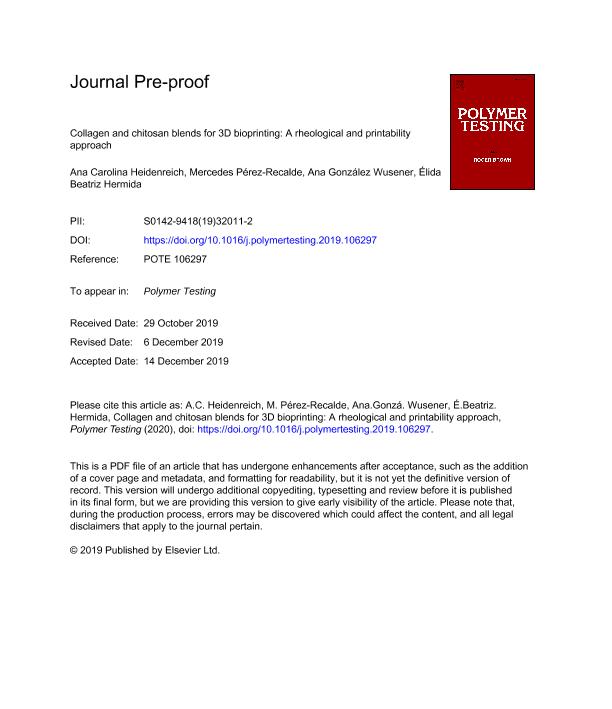Artículo
Collagen and chitosan blends for 3D bioprinting: A rheological and printability approach
Heidenreich, Ana Carolina ; Pérez Recalde, Mercedes; González Sánchez Wusener, Ana Elena
; Pérez Recalde, Mercedes; González Sánchez Wusener, Ana Elena ; Hermida, Elida Beatriz
; Hermida, Elida Beatriz
 ; Pérez Recalde, Mercedes; González Sánchez Wusener, Ana Elena
; Pérez Recalde, Mercedes; González Sánchez Wusener, Ana Elena ; Hermida, Elida Beatriz
; Hermida, Elida Beatriz
Fecha de publicación:
12/2019
Editorial:
Elsevier
Revista:
Polymer Testing
ISSN:
0142-9418
Idioma:
Inglés
Tipo de recurso:
Artículo publicado
Clasificación temática:
Resumen
Collagen and chitosan are widely employed as biomaterials, including for 3D-bioprinting. However, the use of collagen and chitosan (col:chi) blends as bioinks is still scarce. In this work, the rheology of different hydrogel precursors (0.5–1.50% w/v chi: 0.18–0.54% w/v col) was analyzed through frequency and strain sweeps, as well as at different shear rates. Col:chi blends showed a shear-thinning behavior, with viscosity values at low shear rates between 0.35 and 2.80 Pa s. Considering the strain rate determined by the applied flow in a 3D-bioprinter, precursor viscosities during the extrusion were in the interval 0.5–0.8 Pa s. Printability (Pr) was measured comparing images of the printed meshes and the corresponding CAD grid design, using photograph analysis. Col:chi 0.36:1.00 was chosen to print mono-layered scaffolds for tissue engineering (TE) because of its suitable viscosity, printability and polymer ratio content. Hydrogels were obtained through NaHCO3 nebulization and 37° incubation, and NHS/EDC were added to obtain scaffolds with improved mechanical behavior. They were stable after 44 h in PBS with collagenase at physiological level and showed no cytotoxic effect in NIH-3T3 fibroblasts.
Palabras clave:
3D BIOPRINTING
,
HYDROGEL PRECURSOR
,
RHEOLOGY
,
COLLAGEN
,
CHITOSAN
,
BIOINKS
Archivos asociados
Licencia
Identificadores
Colecciones
Articulos (IIBIO)
Articulos de INSTITUTO DE INVESTIGACIONES BIOTECNOLOGICAS
Articulos de INSTITUTO DE INVESTIGACIONES BIOTECNOLOGICAS
Citación
Heidenreich, Ana Carolina; Pérez Recalde, Mercedes; González Sánchez Wusener, Ana Elena; Hermida, Elida Beatriz; Collagen and chitosan blends for 3D bioprinting: A rheological and printability approach; Elsevier; Polymer Testing; 82; 106297; 12-2019; 1-29
Compartir
Altmétricas



